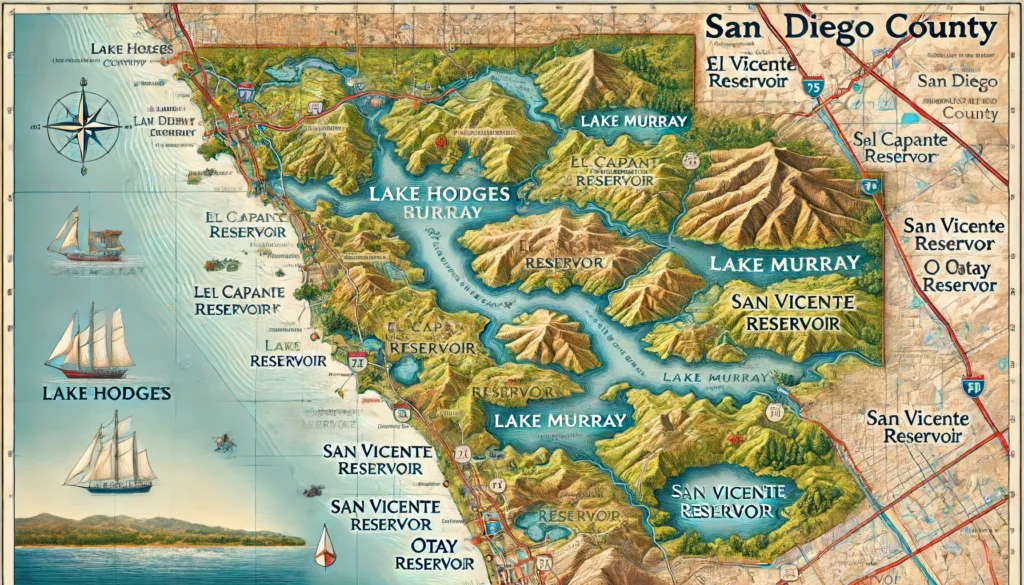San Diego County is not just renowned for its stunning coastline and vibrant urban centers; it also boasts an impressive array of lakes and reservoirs that provide not only critical water resources but also serve as recreational havens. In this article, we’ll delve into the diverse water bodies that dot the county, exploring their significance, unique features, and the recreational opportunities they offer. Whether you’re a local resident or a visitor, understanding these aquatic gems can enrich your appreciation of San Diego’s natural beauty.
The Importance of Lakes and Reservoirs
San Diego’s lakes and reservoirs are more than scenic spots; they play a vital role in water storage, flood control, and ecosystem support. In a region where water is a precious commodity, these bodies of water are crucial for sustaining the local population, agriculture, and wildlife.
Water Storage and Supply
One of the primary functions of reservoirs is to store water for urban and agricultural use. San Vicente Reservoir, for instance, is a critical component of San Diego’s water infrastructure. Expanded in 2014, it can now hold up to 242,000 acre-feet of water, ensuring a reliable supply during dry periods.
Flood Control
Reservoirs like Lake Hodges help mitigate the impact of heavy rainfall by controlling the release of water downstream. This function is essential in preventing floods that could otherwise cause significant damage to communities and ecosystems.
Ecosystem Support
Many of San Diego’s lakes and reservoirs provide habitats for a variety of plant and animal species. Lake Morena, for example, supports diverse wildlife and offers excellent bird-watching opportunities. These water bodies contribute to the overall health of the region’s ecosystems.
Notable Lakes and Reservoirs in San Diego
Let’s take a closer look at some of the most notable lakes and reservoirs in San Diego County, highlighting what makes each one unique and worth visiting.
San Vicente Reservoir
Located in the Cuyamaca Mountains, San Vicente Reservoir is not only a crucial water supply source but also a popular destination for recreational activities. Visitors can enjoy boating, fishing, and picnicking while taking in the stunning mountainous backdrop.
Lake Hodges
Lake Hodges is situated in the heart of the San Dieguito River Park and is a beloved spot for fishing, kayaking, and hiking. The scenic beauty of the lake, combined with its rich biodiversity, makes it a favorite among nature enthusiasts.
Lake Murray
Nestled in the Mission Trails Regional Park, Lake Murray is a small but charming reservoir known for its tranquil atmosphere. It’s an ideal spot for leisurely walks, bird-watching, and fishing. The paved path around the lake is perfect for a relaxing stroll or bike ride.
Lake Cuyamaca
Lake Cuyamaca offers a serene escape in the Cuyamaca Rancho State Park. This picturesque lake is a hotspot for trout fishing and is surrounded by hiking trails that provide breathtaking views of the surrounding landscape.
El Capitan Reservoir
El Capitan Reservoir is another significant water supply source for San Diego. In addition to its practical purpose, it offers excellent opportunities for boating and fishing. The rugged terrain around the reservoir adds to its allure for outdoor adventurers.
Recreational Opportunities
San Diego’s lakes and reservoirs are not just about utility; they are also about enjoyment and recreation. Here are some of the top recreational activities you can indulge in at these water bodies:
1. Fishing: Most lakes and reservoirs in San Diego are stocked with fish species like bass, trout, and catfish. Popular fishing spots include Lake Jennings, Lake Wohlford, and Dixon Lake.
2. Boating: Whether you prefer motor boating, sailing, or kayaking, places like Lake Miramar and San Vicente Reservoir offer ample opportunities to get out on the water.
3. Hiking and Biking: Many reservoirs are surrounded by trails that are perfect for hiking and biking. Lake Poway and Lake Murray have well-maintained paths that provide beautiful views and a chance to enjoy the local flora and fauna.
4. Picnicking: Numerous lakes have designated picnic areas where you can relax with family and friends. Lake Morena and Sweetwater Reservoir are excellent choices for a day out.
5. Wildlife Watching: Bird enthusiasts will find plenty to admire at lakes like Lake Hodges and Lake Cuyamaca, where a variety of bird species can be observed in their natural habitats.
Conservation and Sustainability
The sustainability of San Diego’s lakes and reservoirs is paramount to ensure they continue to provide essential resources and recreational opportunities. Here are some critical aspects of their conservation:
Water Quality Management: Maintaining high water quality is essential for the health of both human populations and ecosystems. Efforts are made to monitor and control pollutants and invasive species that can harm these water bodies.
Habitat Restoration: Many reservoirs are involved in habitat restoration projects aimed at preserving and enhancing the natural environment. This includes planting native vegetation and creating habitats for wildlife.
Community Involvement: Public awareness and involvement are crucial for the conservation of these natural resources. Community programs and volunteer opportunities help educate and engage locals in preserving their local lakes and reservoirs.
Conclusion
San Diego’s lakes and reservoirs are indispensable parts of the county’s landscape, providing essential water resources, supporting diverse ecosystems, and offering a wide range of recreational activities. From the expansive San Vicente Reservoir to the tranquil Lake Murray, each water body has its unique charm and significance. By understanding and appreciating these natural resources, we can better contribute to their preservation and enjoy all the benefits they offer.
Whether you’re an avid angler, a hiking enthusiast, or simply someone who loves to relax by the water, San Diego’s lakes and reservoirs have something for everyone. Next time you’re looking for an outdoor adventure or a peaceful retreat, consider exploring one of these beautiful water bodies. Not only will you be rewarded with stunning scenery and a chance to connect with nature, but you’ll also be supporting the conservation of these vital resources for future generations.

